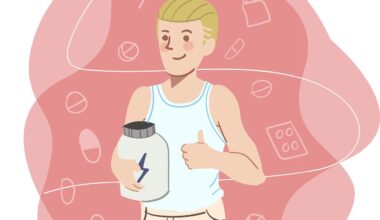Top 10 Kettlebell Exercises for Physical Therapy
Kettlebell rehabilitation exercises provide an excellent means for recovery and strength building. Due to their unique shape, kettlebells can engage more muscle groups than traditional weights can. They create an asymmetrical load that helps develop stability, balance, and coordination. By incorporating kettlebell exercises into your rehabilitation plan, you can improve functional movements such as walking, jumping, and running. It’s crucial to start with proper techniques and focus on movements that are suitable for your specific injuries. Kettlebells are also versatile, which allows for varied workouts. Exercises can be modified to address specific rehabilitation needs, making them suitable for both beginners and advanced users. Consult with a physical therapist to determine the appropriate exercises based on your condition. With consistency, kettlebell workouts can aid in improving strength and overall physical therapy outcomes. With the right implementation, kettlebells can effectively build a strong foundation for future fitness endeavors as well. They encourage functional movement patterns that not only rehabilitate but also prepare individuals for more intense physical activities down the line.
One of the most recommended kettlebell rehabilitation exercises is the kettlebell deadlift. This foundational move is crucial for developing posterior chain strength. It focuses on the hamstrings, glutes, and lower back. Begin with a light kettlebell placed between your feet. Hinge at your hips while maintaining a neutral spine, grasp the kettlebell, and stand tall. Remember to keep your shoulders back and your core engaged. This exercise not only builds strength but also improves mobility and posture, making it perfect for rehabilitation. Aim for a few sets of 10-15 repetitions. Additionally, if you experience discomfort, consider reducing the weight or revisiting your form. Progress gradually by increasing weight as you get stronger. This way, you’ll reinforce proper lifting mechanics that help prevent injuries in the future. Deadlifts serve as an excellent introduction to kettlebell training for those recovering from injuries. They teach the essentials of lifting mechanics while promoting overall body strength. If you want to find more about the kettlebell deadlift, check out this detailed guide here.
Kettlebell Goblet Squat
The kettlebell goblet squat is another powerful rehabilitation exercise. It emphasizes squat mechanics, helping to strengthen the legs and core. This exercise encourages proper squat form by holding the kettlebell close to your chest. Stand with your feet shoulder-width apart while holding the kettlebell with both hands. Lower into a squat, ensuring that your knees stay behind your toes. This not only builds leg strength but also improves hip mobility. For rehabilitation purposes, the goblet squat is crucial in enhancing muscle coordination around the knee joint. It prepares the body for more complex movements. Aim for three sets of 8-12 reps at light to moderate weight. As you progress, you can increase the weight gradually to enhance muscular endurance and strength. Also, focus on your balance and control throughout the movement to foster stability in your legs and core. Emphasizing form and technique is vital in this exercise. Thus, proper guidance from a trained professional can enhance its effectiveness for rehabilitation. For additional tips, consider visiting the expert website here.
Next, the kettlebell swing is highly effective for developing cardiovascular endurance and strength. This dynamic full-body workout improves movement patterns while rehabilitating the shoulders, hips, and lower back. To perform the kettlebell swing, start with your feet slightly wider than hip-width apart, holding the kettlebell in both hands. Hinge your hips back while allowing the kettlebell to swing between your legs. Then, thrust your hips forward, swinging the kettlebell to shoulder height. It’s crucial to keep your back straight and core engaged. Start with lighter weights and focus on the momentum generated by your hips rather than the arms. This can minimize the risk of re-injury. Incorporating swings into your routine fosters a strong core and improves overall functional capacity. Aim for three sets of 10-15 reps. The benefits of kettlebell swings extend beyond basic strength, aiding in the development of explosive movements vital to various physical activities. Additionally, for further insights into mastering kettlebell swings, check out this informative article here.
Single-Arm Kettlebell Row
The single-arm kettlebell row is essential for developing upper body strength while promoting proper posture during rehabilitation. This exercise activates muscles in the back, arms, and shoulders while also engaging the core. Begin by placing one knee and one hand on a bench, keeping the opposite leg extended. Grasp the kettlebell with the free hand and pull it toward your hip, ensuring that your elbow stays close to your body. Maintain a neutral spine throughout the movement. This helps reinforce back health and upper body stability. Perform three sets of 8-12 repetitions per side. The single-arm row not only targets the upper body but also trains the stabilizing muscles of the core, making it an excellent choice for overall fitness. For those in rehabilitation, it’s vital to approach this exercise mindfully to avoid straining the shoulder or lower back. Consequently, consider starting with a lighter kettlebell and gradually increasing the load as your strength improves. For more tips on form and execution, you can refer to this guide.
The kettlebell Turkish get-up is a comprehensive rehabilitation exercise focusing on mobility, stability, and strength. It involves transitioning between lying down and standing while holding the kettlebell overhead. Begin by lying on your back with the kettlebell in one hand and extending your arm straight up. Slowly rise to a seated position, then move to standing while keeping your eyes on the kettlebell. It’s essential to perform each step deliberately and mindfully, making sure to maintain proper form. This exercise effectively engages multiple muscle groups, improving overall coordination and body awareness. Start with a very light kettlebell, especially if you are new to this movement. Aim for three sets of 3-5 repetitions per side. The Turkish get-up is known for its ability to uncover imbalances or mobility issues within the body, making it beneficial for rehabilitation. By consistently practicing the Turkish get-up, you can enhance functional strength and improve overall stability, which are crucial for injury recovery. For detailed instructions on this complex move, check this resource here.
Kettlebell Lateral Lunge
The kettlebell lateral lunge significantly contributes to improved lower body strength and lateral stability. This exercise targets the inner and outer thighs, promoting balance and flexibility, essential for rehabilitation after injuries. Begin by standing with your feet together while holding a kettlebell in one hand. Step to the side with one leg, lowering your body into a lateral lunge while keeping the kettlebell close to your body. This works on strengthening the glutes and quadriceps while improving lateral movement efficiency. Ensure that your knee is aligned over your toes and keep your hips back while performing the movement. Complete three sets of 8-10 reps per side, focusing on gradual progression in both weight and range of motion. By integrating the lateral lunge into a rehabilitation routine, individuals can enhance stability and strength. This is particularly useful for athletes or active individuals recovering from lower body injuries. With careful and consistent practice, this exercise can play a significant role in achieving balanced muscular development. For further information and variations, consider exploring this link.
Finally, the kettlebell windmill serves as a fantastic shoulder and core stability exercise. This requires holding a kettlebell overhead while bending at the waist. It greatly improves flexibility and strength in the hips, shoulders, and core. To perform, stand with feet shoulder-width and hold a kettlebell overhead with one hand. Rotate your torso while bending sideways towards the standing leg while keeping your eyes on the kettlebell. Engage your core and ensure your movements remain controlled. The windmill not only strengthens various muscle groups but also enhances overall stability, which is integral during the rehabilitation process. Aim for three sets of 5-10 repetitions on each side. This exercise encourages awareness of body mechanics, essential for recovery from injuries. It is vital to practice the windmill with intention to avoid any hesitation that may cause discomfort. By mastering this exercise, you can develop efficient movement patterns and increase your ability to perform daily activities post-rehabilitation. For a comprehensive breakdown of this exercise technique, you can check out this helpful article here.


